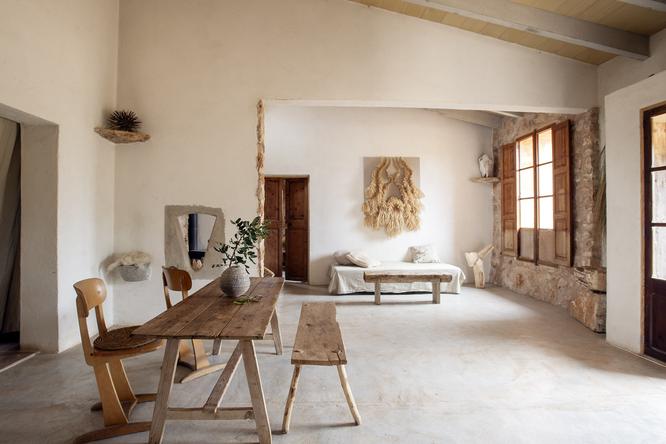The house of the artists Jaume Roig and Adriana Meunié is an old dairy that they rented and has been renovated. It is in the south of Mallorca, in a dry area, and from the outside it looks like a modest country house. Inside, too, it is modest—a living room, a bedroom, a small kitchen, a workroom for each, that's all—but it makes a powerful impression with its elemental beauty. Meunié defines it as “a very simple home, with that point of life, basic and integrated with the environment, from here in Mallorca”. Roig says that it is "a spartan house". The furniture in the room is a sample of said austerity. She speaks seated on a plastic stool rescued from a hair salon that closed. He, in a chair that he composed with a metal structure that he found in the garbage and some old esparto cords that he took from an abandoned rope store. For a bench, he used a railroad tie. And in one corner of the room is a lamp-sculpture that was invented with a metal fishing grid supported by a stick and with a cement drinking trough for cows as a base. A genuine ready-made that reflects their taste for recycling poor materials to give them a new use and illuminate their aesthetic dignity.
The only furniture they paid for is two beech wood chairs that a German biker was selling at a flea market. Roig asked him how much one cost. "Thirty euros," said the biker. Roig then asked him how much it was for both of them: "Thirty-one," the leather-clad German replied without flinching. That answer still seems to them an unfathomable enigma.

Both were born in Mallorca. Adriana Meunié, granddaughter on her mother's side of a couple of Californian beatniks who fell in love with the island, is 36 years old and makes paintings and tapestries with primary materials such as reeds, tow or esparto grass. In addition, he has a clothing brand made in his land called Ódeminuí. Jaume Roig is 39 years old and artistic ceramics and painting converge in his work. Both use the living room to study their pieces. As soon as they finish one, they put it there for a while. They observe it, analyze it, enjoy it, live with it. When we visited them, they had on one wall an abstract painting by Roig and on another a Navarrese wool vest by Meunié designed to function as a painting or as an exaggerated article of clothing.
The room space is ideal for the aesthetic experience. There is nothing to interrupt. The floor is cement. The walls are plastered with a simple waterproof mortar. On these raw surfaces, the Mediterranean sun creates subtle plays of light and shadow.
The house could be said to have a minimalist style, but that might be inappropriate. They don't think it's the adjusted concept. They think that the raison d'être of minimalism lies, above all, in a desire for formal purism. Theirs, they say, is a "more organic and home-like" simplicity. But one would say that his aesthetic is at the same time an ethic, a very conscious way of inhabiting, according to current sensibilities such as environmentalism, criticism of consumerism or the commitment to slowing down life. The slogan would no longer be the mythical "Less is more", but a predicate of subversive obviousness: "Less is less", and there, without further ado, would be the good stuff.
48 Best Parka For Extreme Cold In 2021 Based On 7300 Reviews
Coronavirus Mexico July 4; summary of the latest news, infections and deaths
Bertín Osborne gives Pablo Motos a zasca for 'El Hormiguero': "You don't spend the money"
The dandies of the Congo